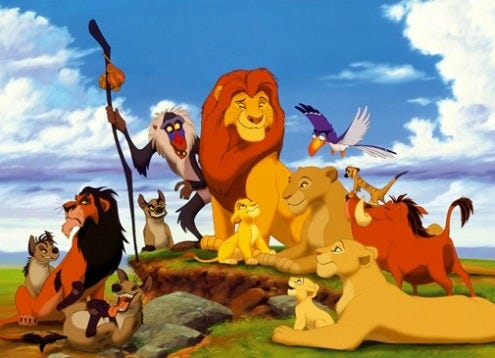The Lion King 3D

"The Lion King" was made a mere 17 years ago but seems from a different era now. The following year, "Toy Story" would come out, and animation was never the same again.
Now being re-released in a 3D version, the rendering of animals has that clean, cutesy look that was a hallmark of Disney cartoons. If it were made today, Simba the lion would have textures and shadings, and computer animators would've spent 10,000 hours getting every hair on his mane to look as lifelike as possible. And the movie wouldn't be nearly as good.
I'm a devotee of CG animation, but the re-release of "The Lion King" reminds us that, like Simba recalling his father's spirit out of the night sky, we don't have to let go of the past in order to move beyond it.
We are in the midst of a second golden age of animation, kicked off by 1989's "The Little Mermaid" and improved upon in 1991's "Beauty and the Beast" and "Aladdin" the following year. But in 1994, the art form reached a watershed with "The Lion King."
Here was a "kiddie" flick that was big, grandiose and ambitious, a sprawling Shakespearean epic playing out on the African savannah. The king Mufasa, given indescribable depth and presence by the voice acting of James Earl Jones, seemed to step out of the papyri of a Greek tragedy.
It would be easy to surmise that Disney releasing a 3D version of "The Lion King" is a mere publicity stunt, a run-up to the Blu-ray version being issued on Oct. 4. Certainly, the 3D effects add little to the experience. The gorgeous landscapes of the lions' prideland pop out a little more, though inevitably everything looks a little dimmer than it ought to.
But for a mere cartoon, this movie is one that needs a huge canvas to do it justice. I've watched "The Lion King" on DVD on my big-screen TV with surround sound, and seeing it in a theater full of families was enthralling in a way home video cannot match.
With half the theater filled with small children, their din of cries and squawks soon faded as the film and I joined. (When my wife dropped her 3D glasses due to our squirmy 10-month-old and needed help retrieving them, she had to poke me several times to break the spell.)
A few new impressions on the movie:
I was surprised how much screen time is spent with young Simba (Jonathan Taylor Thomas) before Mufasa's death and the young cub's exile. My memory was that section was mere prologue, and the film spends most of its running time with him grown up and voiced by Matthew Broderick. In fact, the sections are about evenly split.
The songs, though not quite on the level of the magical "Beauty and the Beast," remain infectiously memorable. Even Jeremy Irons, playing conniving uncle Scar, fakes his way admirably through "Be Prepared" in the grand tradition of talk-singing. Jimmy Cagney and Rex Harrison would be proud.
After the success of Robin Williams voicing the genie in "Aladdin," Disney — which previously used professional voice actors almost exclusively — "The Lion King" ushered in the era of movie stars doing most of the characters. No complaints, given the quality of work here. Robert Guillaume is particularly affecting as crazy baboon/wise shaman Rafiki.
Nathan Lane, a Broadway song-and-dance man who got his break into movie stardom through "The Lion King," is still a hoot as meerkat Timon. He's primarily around as comic relief, but also throws in some sly, sophisticated humor: "Carnivores ... oy!"
The musical score by Hans Zimmer is the heartbeat of the movie. Without his rollicking beats and sweeping, lush strings, the film would lose much of its power. It won the Oscar that year, trumping contenders "Forrest Gump" and "The Shawshank Redemption," and deserved to.
Whatever the reasons behind it, seeing "The Lion King" on the big screen falls into the not-to-be-missed category.
5 Yaps



